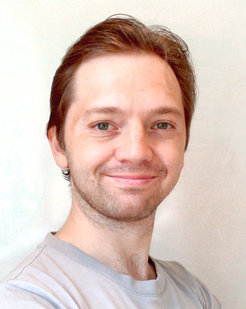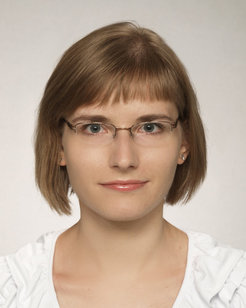Alumni 2014
Nils Lippok (22.1.) - Trifon Trifonov (4.2.) - Tobias Albertsson (15.1.) - Veselina Kalinova (30.4.) - Ellen Andrae (27.6.) - Johannes Ludwig (28.4.) - Rahul Kannan (27.6.) - Charles Majer (9.7.) - Sladjana Knezevic (17.10.) - Thomas Gerner (16.10.) - Jennifer Schober (15.10.) - Lukas Konstandin (16.10.) - Alberto Rorai (14.11.) - John Vickers (27.11.) - Mohamad "Moe" Abbas (12.12.) - Joanna Drazkowska (17.12.) - Denis Yurin (17.11.) - Deniss Stepanovs (10.12.)
Deniss Stepanovs (Latvia) 10.12.2014

Launching Jets and Outflows from Magnetized Accretion Disks. Advection, Diffusion, Dynamo (thesis pdf, 7 MB)
The results of three-dimensional, axisymmetric, magnetohydrodynamic simulations are presented, investigating the launching of jets and outflows from a magnetically diffusive accretion disk. The time evolution of the disk structure is self--consistently taken into account. In contrast to previous works, spherical coordinates for the numerical grid were applied. The new setup made it possible to run simulations for more than 150,000 dynamical times on a domain extending 1500 inner disk radii with a resolution of up to 24 cells per disk height in the inner disk. This, in fact, is the longest and resolved simulation performed so far. A novel approach to the analysis of disk-jet system was developed and interrelations between the properties of the jet and the underlying disk were derived. Using this method, it was shown that it is the actual disk magnetization that best describes the disk--jet evolution. The actual disk magnetization at the jet foot point is the main parameter that governs the properties of the jet, namely all jet steady-state MHD integrals. Depending on the disk magnetization, jet launching occurs in two different but complementary regimes - jets driven predominantly by centrifugal or magnetic forces. These regimes differ in the ejection efficiency concerning mass, energy, angular momentum, and all jet integrals. The self-generation of the magnetic field by a Alpha-Omega mean-field dynamo was also addressed. In this setup, the magnetic flux is continuously generated, diffuses outwards the disk, and fills the entire disk. A magnetic field of the inner disk is similar to open field structure, favoring magneto-centrifugal launching. The outer disk field is highly inclined and predominantly radial. The differential rotation induces a strong toroidal component that plays the key role in the outflow launching. These outflows from the outer disk are slower, denser, and less collimated. A toy--model triggering a time-dependent mean-field dynamo was invented. The general result is that the episodic ejection and large-scale jet knots can be steered by a time-dependent dynamo that regenerates the jet-launching magnetic field.
Supervisor: Christian Fendt (MPIA)
Denis Yurin (Kazakhstan) 17.12.2014

Construction and stability of disk galaxies, and the radial migration of their stars (thesis pdf, 7 MB)
This thesis studies the stability of disk galaxies and the radial migration rate of their stars in self-consistent cosmological models of the formation of Milky Way-sized galaxies. In order to carry out appropriate numerical experiments, we first develop a new method for creating multi-component N-body galaxy models in a stationary state. Unlike previous techniques, this approach can flexibly cope with nearly arbitrary axisymmetric density distributions, and allows the construction of disk galaxy models with distribution functions that have three integrals of motion. To demonstrate the capability and accuracy of our parallel code GALIC in which we implemented the method, we examine 20 different galaxy models and study their stability when evolved as a live N-body system, finding very good results. We then apply the method to study the evolution of thin disk galaxies inserted in high-resolution dark matter halos drawn from the Aquarius simulation suite. The galaxy models are constructed with GALIC and are adiabatically grown in the evolving dark matter halo from redshifts z = 1:3 to z = 1:0, and then evolved live for a period of about 6 Gyrs to the present epoch. Our analysis of the simulations explores to what extent the galaxies are affected by the dark matter halo’s triaxiality and the large number of dark matter subhalos orbiting in it, and by how much the disk orientation is tumbling during this evolution. Finally, we study the radial migration of stars in hydrodynamical simulations of the same Milky Way-sized galaxies, carried out with the novel moving-mesh code AREPO. We are especially interested in the question whether radial migration can strongly modify metallicity gradients and the age-metallicity relation in such galaxies, and whether it can potentially contribute to the formation of a thick disk component.
Supervisor: Volker Springel (HITS)
Joanna Drazkowska (Poland) 17.12.2014

From Dust to Planetesimals ( thesis pdf, 7 MB)
It is now clear that on average every star in the Milky Way has at least one planet. Planet formation seems to be an inevitable side effect of the star formation process. However, there are several problems that make it difficult to understand how the primordial micrometer dust grains observed in protoplanetary disks are turned to planets. One of them is the formation of kilometer-sized planetesimals, which is the topic of this dissertation. We first develop a new code for dust evolution in protoplanetary disks, which is based on the Monte Carlo approach. The code is then used to model several possible planetesimal formation scenarios. We test planetesimal formation by both dust coagulation and gravitational collapse of dense pebble clumps formed by the streaming instability. We examine what conditions are necessary for these scenarios to proceed and compare their planetesimal formation efficiencies. Our results suggest that planetesimal formation via dust coagulation is possible in the inner part of the protoplanetary disk, whereas the streaming instability may only be efficient beyond the snow line. Our predictions can be used to model the late stages of planet formation.
Supervisor: Cornelis Dullemond (ITA)
Mohamad "Moe" Abbas (Lebanon) 12.12.2014

RR Lyrae stars: Substructures and the Oosterhoff dichotomy in the Halo of the Milky Way ( thesis pdf, 20 MB)
We present the detection of 6371 RR Lyrae (RRL) stars distributed across 14000 deg2 of the sky from the combined data of the Sloan Digital Sky Survey (SDSS), the Panoramic Survey Telescope and Rapid Response System 1 3pi survey (PS1), and the repeated observations from the second photometric catalogue from the Catalina Survey (CSDR2). Around 2000 of these stars are new discoveries. The completeness level of our RRL stars (4800 RRab and 1571 RRc stars) is 50 % while the efficiency levels for RRab and RRc stars are 99 % and 87 %, respectively. We show that our method for selecting RRL stars allows us to recover halo substructures. Moreover, we present a method for selecting RRL stars and other types of variable stars in the absence of a large number of multi-epoch data and light curve analyses. Our method uses a Gaussian Mixture Bayesian Generative technique (GMM) to apply SDSS color and PS1 variability cuts instead of the commonly used rectangular cuts. A comparison between our efficiency and completeness levels using the GMM method to the efficiency and completeness levels using rectangular cuts that are commonly used yielded a significant increase in the efficiency level from 13% to 77% and an insignificant change in the completeness levels. Although we develop it over the SDSSxPS1 footprint, our technique would work well on any multi-band, multi-epoch survey for which the number of epochs is limited. Additionally, we study the different Oosterhoff populations (OoI and OoII) in the Milky Way's halo using the largest catalog of RRab stars from the Catalina Sky Survey (CSS). We show that 73% of the halo RRab stars are of OoI type (RRabOoI ) and that the latter stars are more metal-rich compared to RRabOoII stars. By examining the change of RRabOoI and RRabOoII stars with Galactocentric distances (Rgc), we detect two turning points at Rgc 25 kpc and Rgc 45 kpc. We believe that these turning points are associated with breaks in the power-laws of the halo and that they divide the stellar halo into three main components: the inner halo, the outer halo, and the ''extreme outer halo'' components. We also study the Oosterhoff populations of the RRL stars in the direction of the trailing arm of the Sagittarius dwarf spheroidal (dSph) galaxy, the Virgo substructure, and the Hercules-Aquila Cloud and we conclude that these substructures are dominated by RRabOoI stars (80%) and that the mean periods of their RRab stars fall near the boundary of the Oosterhoff gap; results that suggest that they had dSph galaxy progenitors.
Supervisor: Eva Grebel (ARI)
John Vickers (USA) 27.11.2014
Stellar Tracers and Galactic Exploration ( thesis pdf, 8 MB)
This dissertation discusses various techniques for studying the structure of the Milky Way via the use of stellar tracers. One of the most widely used stellar tracers is blue horizontal branch stars, which are prized for their predictable and substantial intrinsic brightnesses and their old ages. We begin by creating a z based photometric color cut for the selection of blue horizontal branch stars which may be used in data produced by the Panoramic Survey Telescope and Rapid Response System. Using this color cut, we select a sample of blue horizontal branch stars and pass them through a newly devised search algorithm which is capable of finding overdensities in incomplete and patchy data. From this, we rediscover a number of well known Milky Way features and discover a new constraining detection of the Sagittarius tidal streams. If we use spectroscopy in addition to photometry, we can isolate another stellar tracer, main sequence stars. A main sequence star's intrinsic magnitude is a function primarily of the mass and metallicity of the star; so with spectroscopy and photometry we can easily estimate the distance to these types of objects. We collect a sample of F-M type dwarf stars from the Sloan Digital Sky Survey spectroscopic data set. Having spectroscopy and astrometry, we may assign six-dimensional phase information to these objects and then use that information to study their bulk motions as a function of position. Here, instead of looking for large structure, we instead look to aberrations from large structure: using this relationship between motion and position as a probability density function, we select and characterize significant outliers. We also identify phenomenological objects such as hypervelocity and Hills stars. These types of stars are indirect probes of the Milky Way and are most useful for studying: the potential of the Milky Way, the locations of extreme overdensities such as spiral arms or black holes, and the structure of observationally obscure areas like the Galactic nucleus. During these studies of the motions and positions of stellar tracers in the Milky Way, accurate reports of the proper motions are of critical importance. To investigate this we closely examine proper motions in the Sloan Digital Sky Survey and the PPMXL proper motion catalogs and devise metrics for estimating the accuracy of these proper motion valuations and corrections to erroneous proper motions where applicable.
Supervisor: Eva Grebel (ARI)
Alberto Rorai (Italy) 14.11.2014

Measuring the Small Scale Structure of the Intergalactic Medium ( thesis pdf, 4 MB)
The small-scale structure of the intergalactic medium (IGM) is fundamental to our understanding of cosmology and structure formation. Although the baryons trace dark matter fluctuations on megaparsec scales, on small scales ($\sim 100$ kpc), gas perturbations are regulated by hydrodynamics and they are thought to be suppressed by pressure below a characteristic \emph{filtering scale} $\lambda_J$, analogous to the classic Jeans scale. The value of this Jeans filtering scale is set by the interplay between pressure support and gravity across the cosmic history, and has fundamental cosmological implications. First it provides a thermal record of heat injected by ultraviolet photons during cosmic reionization events, and thus constraints the thermal and reionization history of the universe. Second, it determines the clumpiness of the IGM and the minimum mass for gravitational collapse from the IGM, playing a pivotal role in galaxy formation and reionization. In principle, the sign of Jeans smoothing could be probed by the redshifted \mlya\ absorption lines in the spectra of high-redshift quasars (The \mlya\ forest). Unfortunately, this is extremely challenging to do because the thermal Doppler broadening of \mlya\ lines along the observing direction is highly degenerate with pressure smoothing. In this work, I explicitly show what degeneracies hold among the thermal parameters of the IGM when only line-of-sight observations are possible. For this purpose, I devised a rigorous statistical algorithm based on Gaussian processes and Markov-Chain Monte Carlo methods, trained on a grid of semianalytical models of the IGM. I then introduce a novel method able to measure the Jeans scale by estimating the transverse coherence in the spectra of close quasar pairs (transverse separation $r_{\perp}< 1$ Mpc). This method is based on the phase differences of homologous Fourier modes in the \mlya\ forests of quasar pairs, and I prove that it is maximally sensitive to $\lambda_J$ and only weakly dependent on the other considered parameters. The available sample of quasar pairs is analyzed, after careful calibration of noise, resolution, and other possible systematics. Our new method applied to this dataset provides the first measurement of the filtering scale of the intergalactic medium. A first comparison of our findings with hydrodynamical simulations suggests that the filtering scale predicted by the standard thermal models of the IGM is significantly higher than what we observe, motivating further theoretical studies to understand this discrepancy.
Supervisor: Joseph Hennawi (MPIA)
Lukas Konstandin (Germany) 16.10.2014

Understanding the statistical properties of supersonic turbulence in hydrodynamical simulations (thesis pdf, 6 MB)
Turbulence is a dominant feature operating in gaseous flows in a variety of systems, from aerodynamics to highly compressible media common in astrophysical environments. We present a systematic analysis of the influence of different forcing types on the statistical properties of supersonic, isothermal turbulence in both the Lagrangian and Eulerian frameworks. We study a series of high-resolution, hydrodynamical grid simulations and examine the effects of solenoidal (divergence-free) and compressive (curl-free) forcing as well as varying root mean square Mach numbers on the parameters describing the statistical state of the system. The probability density functions of the gas density, velocity, and the velocity increments are measured. Structure functions and power spectra are investigated to quantify the two-point correlation properties of compressible turbulence. We find that the mode of the forcing mechanism has an influence on the all measurements mentioned above. Compressively driven simulations show a more intermittent behaviour, a larger fractal dimension of the most dissipative structures (Chapter 4), a significantly larger density contrast with more pronounced wings of the density PDF (Chapter 5), and steeper power spectra with a decreased influence of the bottleneck effect (Chapter 6), at the same root mean square Mach number.
Supervisor: Ralf Klessen (ITA)
Jennifer Schober (Germany) 15.10.2014

On the Role of the Turbulent Dynamo in the Evolution of Cosmic Magnetic Fields ( thesis pdf, 7 MB)
The aim of this work is to explore the origin of magnetic fields in the Universe. We claim that the turbulent or small-scale dynamo, which amplifies weak seed fields on short timescales in the presence of turbulence, plays an important role in the evolution of cosmic magnetic fields. The theoretical model for the turbulent dynamo is generalized for various astrophysical environments, with a focus on different turbulence spectra. We derive analytical solutions for the dynamo growth rate in the kinematic phase and discuss the subsequent non-linear evolution as well as saturation. In the history of the Universe turbulence is expected to be driven efficiently at the latest during the formation of the first stars and galaxies, where gravitational energy is converted into chaotic motions as the dark matter halos accrete gas from the environment. We model these processes semi-analytically and implement magnetic field amplification by a turbulent dynamo. Our results show that unordered magnetic fields, with strengths comparable to the ones in local galaxies, were already present in the primordial Universe. A potential observational test for magnetic fields in young galaxies is suggested to probe our proposed scenario for the evolution of cosmic magnetic fields.
Supervisor: Ralf Klessen (ITA)
Thomas Gerner (Germany) 16.10.2014

Chemical characterization of the early evolutionary phases of high-mass star-forming regions ( thesis pdf, 5 MB)
The formation of high-mass stars is a very complex process and up to date no comprehensive theory about it exists. This thesis studies the early stages of high-mass starforming regions and employs astrochemistry as a tool to probe their different physical conditions. We split the evolutionary sequence into four observationally motivated stages that are based on a classification proposed in the literature. The sequence is characterized by an increase of the temperatures and densities that strongly influences the chemistry in the different stages. We observed a sample of 59 high-mass star-forming regions that cover the whole sequence and statistically characterized the chemical compositions of the different stages. We determined average column densities of 18 different molecular species and found generally increasing abundances with stage. We fitted them for each stage with a 1D model, such that the result of the best fit to the previous stage was used as new input for the following. This is a unique approach and allowed us to infer physical properties like the temperature and density structure and yielded a typical chemical lifetime for the high-mass star-formation process of 105 years. The 18 analyzed molecular species also included four deuterated molecules whose chemistry is particularly sensitive to thermal history and thus is a promising tool to infer chemical ages. We found decreasing trends of the D/H ratios with evolutionary stage for 3 of the 4 molecular species and that the D/H ratio depends more on the fraction of warm and cold gas than on the total amount of gas. That indicates different chemical pathways for the different molecules and confirms the potential use of deuterated species as chemical age indicators. In addition, we mapped a low-mass star forming region in order to study the cosmic ray ionization rate, which is an important parameter in chemical models. While in chemical models it is commonly fixed, we found that it strongly varies with environment.
Supervisor: Henrik Beuther (MPIA)
Sladjana Knezevic (Serbia) 17.10.2014

An Integral View of Shocks ( thesis pdf, 14 MB)
The subject of this thesis are Balmer-dominated shocks around (super)novae. These are characterized by strong hydrogen emission lines with a narrow (~10km/s) and a broad (~1000km/s) component. Studying shock physics is important for improving distance estimates to (super)novae, for understanding their evolution and impact on the interstellar medium, and for obtaining insights into the cosmic ray origin in the remnants of supernovae. Two historical supernova remnants, SN 1006 and SN 1572 (Tycho), are investigated using high-resolution spectrophotometric imaging. Analyzing the widths and intensities of the narrow and broad H�alpha-line components, evidence of suprathermal protons – seeds of high-energy cosmic ray protons – is found in SN 1006. Those cause an underestimation of the estimated shock velocity and, hence, the distance to the remnant. In SN 1572, our observations indicate an additional intermediate-width (~100km/s) component, implying the presence of a broad-neutral precursor. Moreover, the narrow component is typically broader than the maximally expected 20 km/s and is sometimes even doublepeaked, which might be due to a cosmic-ray precursor or the shock geometry. The last part of the thesis outlines how high-spatial resolution spectrographs can be used to study and better understand outflow mechanisms of novae, here of a classical nova FH Ser. Further development of shock models that include non-thermal physics, and their application to the data presented in this thesis, are expected to provide important constraints on hadronic cosmic ray properties.
Supervisor: Glenn van de Ven (MPIA)
Charles Majer (Germany) 09.07.2014

Joint reconstruction of the mass distributions of galaxy clusters from gravitational lensing and thermal gas ( thesis pdf, 3 MB)
We focus on the reconstruction of mass distributions of the massive galaxy clusters, which are the largest gravitationally bound objects in the Universe. An approach to determine the masses of clusters is based on the effects of gravitational lensing. Estimating errors induced by this method is crucial but computationally expensive. We present a novel approach to estimate analytically the errors made by reconstructions which use weak-lensing information. As galaxy clusters host a large amount of intracluster medium they provide a multitude of observables. We present a new method to infer the lensing potential from two of these: signals of the thermal Sunyaev-Zel’dovich effect and the emission of X-rays due to thermal bremsstrahlung. By assuming that the gas is in hydrostatic equilibrium and follows a polytropic equation of state, we link these observables to the gravitational potential, which is then projected along the line-of-sight to infer the lensing potential. For this we deproject the observables by means of the Richardson-Lucy algorithm. We test our method on clusters with analytic profiles, a numerical simulation and on the galaxy cluster RXJ1347. Our efforts are the first steps towards a non-parametric algorithm for a joint cluster reconstruction. By taking all possible cluster observables into account, mass distributions of clusters will be determined more accurately.
Supervisor: Matthias Bartelmann (ITA)
Rahul Kannan (India) 27.06.2014

Hydrodynamic simulations of galaxy formation in a cosmological context (thesis pdf, 11 MB)
The formation of galaxies and their subsequent evolution through cosmic time is governed by a variety of complex physical processes such as gas cooling, star formation, feedback and merger events. In this thesis we use hydrodynamical simulations to study the effect of these processes on galaxy properties. We first investigate the change in galaxy morphology as they undergo mergers. We look at a wide variety of merger events from interaction between small dark matter subhaloes and galactic discs, to major mergers. In the second part of the thesis we turn our attention to the role of stellar feedback in regulating star formation. A model for short range photoheating of gas by radiation from massive stars is tested by simulating a representative volume of the Universe and comparing the statistical properties of simulated galaxies with the observed ones. Finally, we introduce a new, computationally efficient model to calculate the gas cooling rate in the presence of local radiation fields. The model uses simple assumptions for absorption of ultra-violet photons and an optically thin approximation to propagate local radiation fields throughout the entire simulation volume. Using this new method we show that local radiation has a significant effect in regulating the star formation rate of L* galaxies. It reduces gas accretion onto the disc, thereby, producing realistic galaxies without resorting to extreme feedback mechanisms.
Supervisor: Andrea Maccio (MPIA)
Johannes Ludwig (Germany) 28.04.2014

A survey of dwarfs and tidal debris around nearby massive galaxies - deep imaging with medium-sized telescopes (thesis pdf, 64 MB)
The goal of this thesis was to search for interaction signatures among massive galaxies and to quantify the properties of their satellites. We performed deep wide-field imaging on nearby massive spiral galaxies in a distance range of 8 to 35 Mpc. The spirals cover a variety of morphologies and are located in environments of different densities and richness. We studied the surroundings of 47 massive galaxies. 29 targets were studied in detail. For all of them, we were able to detect dwarf companions. In total we found 55 mostly new candidate dwarf galaxies (CDG), on average about two CDGs per target. Based on their structural parameters and colors, we classified the majority of the CDGs as dwarf spheroidal galaxies, but also dwarf elliptical and dwarf irregular galaxies are included in the sample. The satellites’ observed surface brightness in the B-band falls in the range 22 < mu_B < 26 mag arcsec−2, the colors vary from 0.8 < (B − R)_0 < 1.5 mag, and the measured range of luminosities is −8 < M_B,0 < −17. The number of CDGs observed is quantitatively in agreement with the expected number compared to the Milky Way or M31 within our sensitivity limits. Furthermore, about 54% of our host galaxies show signs of tidal interactions. These range from prominent tidal tails, plumes and clouds to thin and faint stellar streams. 35% of the massive galaxies exhibit signs of tidal tails or bridges, 11% show plumes or clouds, and only 8% show stellar streams. We discuss possible progenitors of these features based on their colors.
Supervisor: Eva Grebel (ARI)
Ellen Andrae (Germany) 27.06.2014

The GALEX-GAMA survey and its application to the statistical inference of the attenuation of starlight by dust in spiral galaxies (thesis pdf, 19 MB)
This thesis describes a new widefield survey of the UV broadband emission from a complete flux-limited sample of galaxies in the local Universe conducted with the Galaxy Evolution Explorer (GALEX). I develop techniques to reliably measure UV photometry from galaxies catalogued in the Galaxy and Mass Assembly (GAMA) spectroscopic survey, accounting for the influence of varying UV background, neighbouring sources and measurement artefacts. I also develop the framework for a statistical technique for the inference of the intrinsic UV emission of stars in the population of spiral galaxies, correcting for the effects of attenuation of UV light by dust in flux-limited samples. This technique incorporates for the first time an explicit treatment of the dependency of the attenuation on orientation, size, and morphology of the galaxies. This is a prerequisite for the use of the UV data to infer the present and past evolution of local Universe galaxies from the UV-optical photometry.
Supervisors: Richard Tuffs, Werner Hofmann (MPIK)
Veselina Kalinova (Bulgaria) 30.04.2014

Mass distributions of galaxies from SAURON and CALIFA stellar kinematic maps (thesis pdf, 12 MB)
The amount and distribution of dark matter in galaxies defines the formation, evolution and dynamics of these systems. In this thesis we infer the internal mass distributions of 26 E-Sd galaxies using SAURON and CALIFA two-dimensional stellar kinematic maps. We compare two modeling approaches - fitting a solution of the axisymmetric Jeans equations and the commonly applied asymmetric drift correction (ADC). We show that ADC underestimates the enclosed mass by a factor of ~3-4 once random motion (velocity dispersion) becomes significant compared to ordered motion (streaming), that is, when the ratio of ordered-over-random motion is less than about 1.5. Such kinematics indicate that the stellar mass of the galaxy is not confined to the disk plane, as happens in bulges and thick disks of spiral galaxies, as well as in elliptical galaxies. Since this is frequently realized in our sample, as well as in the general galaxy population, a full line-of-sight integration as provided by solutions of the axisymmetric Jeans equation is needed to reliably infer mass distributions in galaxies. We henceforth use the more realistic Jeans models to estimate the dark matter fraction (fDM), by modeling the total (dynamical) mass-to-light ratio and comparing it with the value derived for stars (baryons) from stellar population models. We find several trends of dark matter fraction with global galaxy properties. Ellipticals (E) and late-type spiral (Scd-Sd) galaxies are the most dark matter-dominated objects, while lenticular (S0) and early-type spirals (Sa-Sb) have significantly smaller dark matter fractions. On average, fDM increases both at highesta and lowest galaxy (stellar) masses, and is smaller at intermediate masses. Further, it is also anticorrelated with the ratio of ordered-over-random motion, that is dispersion-dominated galaxies show a higher dark matter fraction. Finally, we investigate the maximum circular velocities and qualitative shape of rotation curves as a function of galaxy morphological type along the Hubble sequence. Peaked rotation curves are found in early-type galaxies, while slowly rising rotation curves are typical for late-type spirals. This confirms predictions of recent simulations of galaxy evolution with local photoionization feedback. More generally, our results for dark matter content and dynamics provide empirical constraints on current and future theoretical models of galaxy evolution across a wide range of galaxy morphological types and masses, and thereby will help us to understand the relevant physical processes.
Supervisor: Glenn van de Ven (MPIA)
Tobias Albertsson (Sweden) 15.01.2014

Deuterium fractionation in the interstellar medium (thesis pdf, 2 MB)
To date more than 170 species have been identified in interstellar space, and the chemical processes that govern their formation and destruction are driven by thousands of reactions connecting hundreds of atomic and molecular species. The study of these species give us essential information on the physical and chemical processes of astrophysical environments. Studies of deuterated species give us important clues also on the chemical ages and thermal history of these environments. As we enter a new exciting era with highly sensitive measurements of the chemical cosmos provided by ALMA, there is a need for new sophisticated models to analyze the forthcoming wealth of data. The purpose of this thesis is to develop a sophisticated chemical model for studying the deuterium chemistry, benchmark it and its uncertainties and to utilize it to model increasingly more complex star-formation environments. We benchmark the deuterium chemistry model by comparing the calculated to observed D/H ratios of a variety of mono-, doubly-, and triply-deuterated species in distinct astrophysical environments. Uncertainties in abundances and D/H ratios are quantified by a sensitivity analysis, and the most problematic reactions are also identified to aid future laboratory experiments. Ortho-para chemistry has been found to have a profound effect on the pace of deuterium fractionation. The ortho-para model is developed and used successfully to study the para-fractions in diffuse clouds where we improve our understanding of the underlying chemistry of H3+ and H2. Finally, high-temperature reactions are added to the network and used in a study of the origin of Earth's ocean water and the water in primitive bodies of the Solar system (comets and asteroids).
Supervisors: Dimitry Semenov, Thomas Henning (MPIA)
Trifon Trifonov (Bulgaria) 04.02.2014

Planetary dynamics and high precision optical and near-IR spectroscopy. Testing the planetary hypothesis around evolved K-giants (thesis pdf, 20 MB)
The aim of my PhD dissertation is the detection and characterization of extrasolar planets around evolved intermediate stars using precise Doppler spectroscopy. I worked with a sample of G and K giants, which have been observed since 1999 at Lick Observatory. Finding planets around evolved stars, however, is an ambitious task. Giants can exhibit intrinsic long-period RV variations that can effectively mimic a planet, such as large surface spots or even non-radial g−mode pulsations. Given the fact that Hamilton spectra have relatively low resolution (R = 60 000) for line profile analysis, those phenomena cannot be excluded. My research focuses on proving the planetary hypothesis for those objects in our science sample that show well-defined RV signature consistent with one or more sub-stellar companion(s). Thus, I have applied two quantitative tests that can finally close the case for our planetary candidates: First, I have developed a data reduction pipeline for the ESO near infrared spectrograph CRIRES (R = 100 000). I have obtained precise RV from the near-IR, and I searched for consistency with the Lick optical data. Intrinsic stellar RV variations will lead to differences in RV phase and amplitude between the optical and near-IR, while, in case of a planet, both data sets are expected to be consistent. Second, I have constructed detailed χ2red grids in order to explore the dynamical properties of the fits around the best fit. Each orbital configuration from the χ2red grids have been tested with the Mercury N-body simulator. Both methods turned out to be very successful and are included as separate parts of my PhD thesis. The near-IR velocity precision is in the order of 30−40 m s−1 , enough to confirm the RV phase and amplitude, and thus, the planetary nature of most of our candidates. The dynamical fitting shows better χ2red values than the multiple Keplerian model. This is a prove that indeed interacting planets are responsible for the Doppler shift. The long term stability test shows that some systems have a stable best fit, while the rest have broad and confident long term-stable regions in orbital parameter space within 1 or 2 sigma from the best fit.
Supervisor: Andreas Quirrenbach (LSW)
Nils Lippok (Germany) 22.01.2014

Earliest Phases of Star Formation - Physical and Chemical Properties of Prestellar Cores (thesis pdf, 5 MB)
With the goal of constraining the initial physical and chemical conditions of low-mass star formation, the thermal dust emission of a sample of prestellar cores has been observed with the Herschel Space Observatory. From these observations, the most accurate maps of the dust temperature and density structures in prestellar cores existing today have been derived using a ray-tracing technique. Based on this new information on the physical conditions in the prestellar cores I model the chemical evolution of the associated gas. Comparison of the models to molecular line observations reveals that CO freezes out strongly in the core centers and that even the high density tracer N2H+ is affected by depletion. I derive a chemical age of the gas in all cores on the order of 10^5 yr which is comparable to the free-fall time of the cores. Furthermore, I calculate the thermal equilibrium distributions of the prestellar cores between the two methods confirming the reliability of the ray-tracing technique. It is also shown that the agreement is good for a large range of dust models. Finally, I present ammonia observations of three prestellar cores and use them as a gas temperature probe. Comparison of gas and dust temperatures shows that both agree in the inner parts of two cores traced by ammonia while the gas is slightly warmer than the dust in the third object; maybe due to a reduced collisional coupling between gas and dust because of coagulation of the dust grains.
Supervisors: Ralf Launhardt, Thomas Henning (MPIA)
















